产品-MSDS-物质成分中英文格式备课讲稿
- 格式:doc
- 大小:80.50 KB
- 文档页数:6
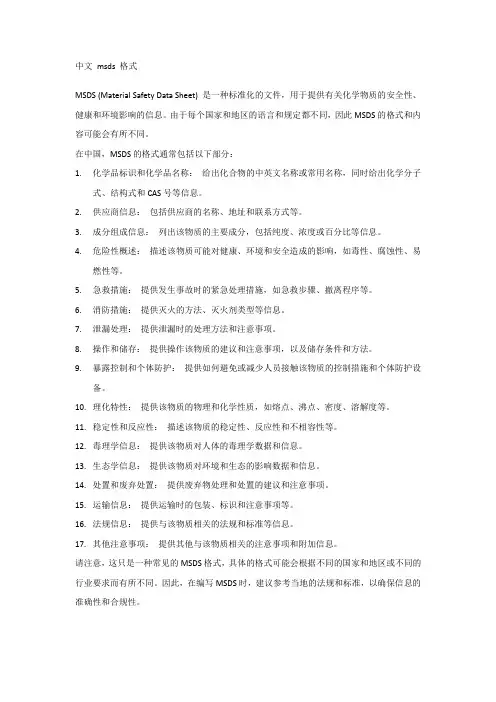
中文msds 格式MSDS (Material Safety Data Sheet) 是一种标准化的文件,用于提供有关化学物质的安全性、健康和环境影响的信息。
由于每个国家和地区的语言和规定都不同,因此MSDS的格式和内容可能会有所不同。
在中国,MSDS的格式通常包括以下部分:1.化学品标识和化学品名称:给出化合物的中英文名称或常用名称,同时给出化学分子式、结构式和CAS号等信息。
2.供应商信息:包括供应商的名称、地址和联系方式等。
3.成分组成信息:列出该物质的主要成分,包括纯度、浓度或百分比等信息。
4.危险性概述:描述该物质可能对健康、环境和安全造成的影响,如毒性、腐蚀性、易燃性等。
5.急救措施:提供发生事故时的紧急处理措施,如急救步骤、撤离程序等。
6.消防措施:提供灭火的方法、灭火剂类型等信息。
7.泄漏处理:提供泄漏时的处理方法和注意事项。
8.操作和储存:提供操作该物质的建议和注意事项,以及储存条件和方法。
9.暴露控制和个体防护:提供如何避免或减少人员接触该物质的控制措施和个体防护设备。
10.理化特性:提供该物质的物理和化学性质,如熔点、沸点、密度、溶解度等。
11.稳定性和反应性:描述该物质的稳定性、反应性和不相容性等。
12.毒理学信息:提供该物质对人体的毒理学数据和信息。
13.生态学信息:提供该物质对环境和生态的影响数据和信息。
14.处置和废弃处置:提供废弃物处理和处置的建议和注意事项。
15.运输信息:提供运输时的包装、标识和注意事项等。
16.法规信息:提供与该物质相关的法规和标准等信息。
17.其他注意事项:提供其他与该物质相关的注意事项和附加信息。
请注意,这只是一种常见的MSDS格式,具体的格式可能会根据不同的国家和地区或不同的行业要求而有所不同。
因此,在编写MSDS时,建议参考当地的法规和标准,以确保信息的准确性和合规性。
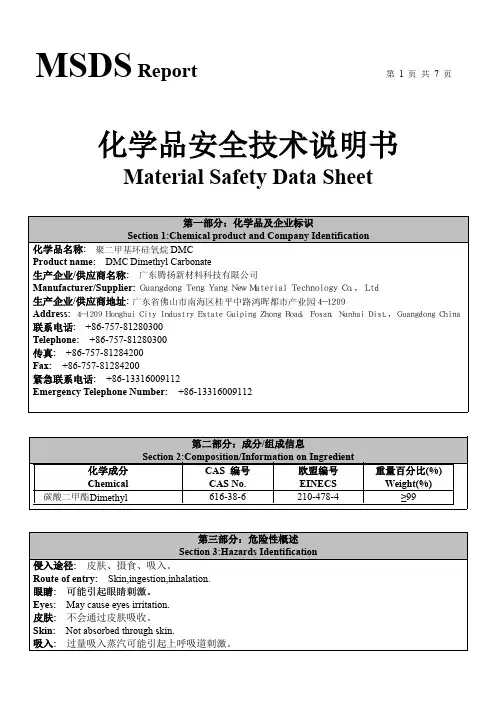
化学品安全技术说明书Material Safety Data SheetInhalation:Excessive inhalation of vapors may cause respiratory irritation.摄取:可能引起胃肠道刺激、恶心、呕吐和腹泻。
Ingestion:May cause gastrointestinal irritation,nausea,vomiting and diarrhea.governmental permits.参考其它部分Reference to other sections参考第7部分安全处置信息。
See Section7for information on safe handling.参考第8部分个人陪护信息。
See Section8for information on personal protection equipment.参考第13部分废弃信息。
See Section13for disposal information.Carcinogenicity:Not a known or suspected carcinogen.慢性毒性:无资料。
Chronic Toxicity:No information available.致敏性:不被归类于致敏物。
Sensitization:Not classified as a sensitizer.:无Marine pollutants:包装方法:Packing method:运输注意事项:海洋污染物None开口钢桶。
安瓿瓶外普通木箱,螺纹口玻璃瓶、铁盖压口玻璃瓶、塑料瓶或金属桶(罐)外普通木箱等。
按照生产商推荐的方法进行包装。
An opening steel barrel. Common wooden casesoutside ampoules, threadedglass bottles, iron cover pressure glass bottles, plastic bottles or metal barrels(cans),outside ordinary wooden boxes, etc. Carry out the packing according to themethod recommended by the manufacturer.Matters of attentionto transportation:装运该物品的车辆排气管必须配备阻火装置,禁止使用易产生火花的机械设备和工具装卸。

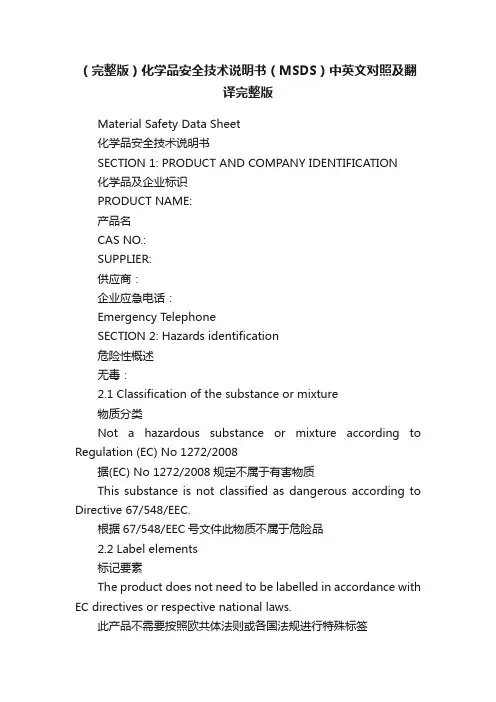
(完整版)化学品安全技术说明书(MSDS)中英文对照及翻译完整版Material Safety Data Sheet化学品安全技术说明书SECTION 1: PRODUCT AND COMPANY IDENTIFICATION化学品及企业标识PRODUCT NAME:产品名CAS NO.:SUPPLIER:供应商:企业应急电话:Emergency TelephoneSECTION 2: Hazards identification危险性概述无毒:2.1 Classification of the substance or mixture物质分类Not a hazardous substance or mixture according to Regulation (EC) No 1272/2008据(EC) No 1272/2008规定不属于有害物质This substance is not classified as dangerous according to Directive 67/548/EEC.根据67/548/EEC号文件此物质不属于危险品2.2 Label elements标记要素The product does not need to be labelled in accordance with EC directives or respective national laws.此产品不需要按照欧共体法则或各国法规进行特殊标签2.3 Other hazards – none其他危害有毒:In-taking Pathways: drug abuse, skin or eyes contact侵入途径:吸入、皮肤、眼、误服Health hazards健康危害Eye contact: May cause eye irritation, redness, tearing or blurred vision眼接触:可引起眼睛刺激、发红、流泪、视力模糊。
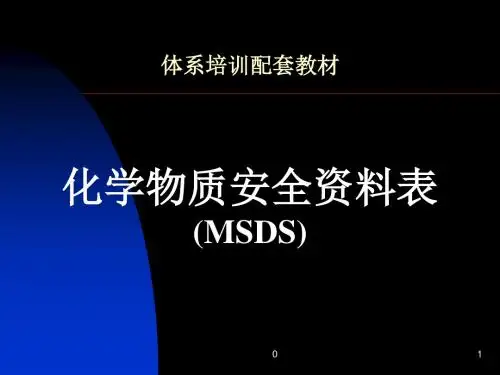
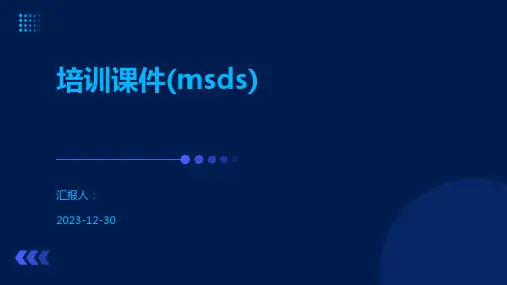
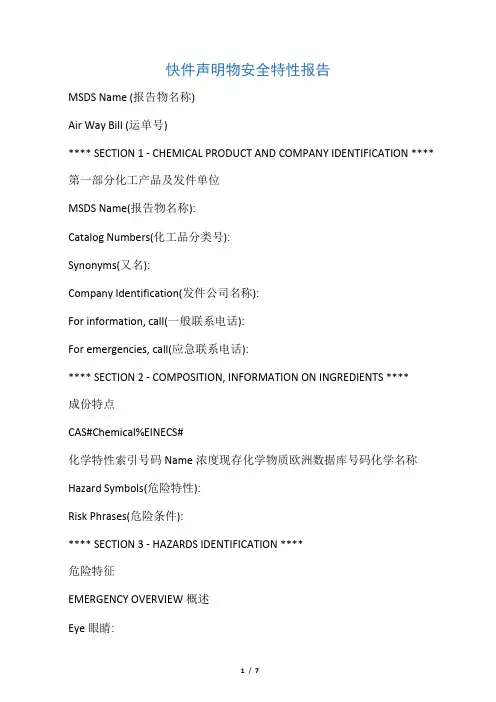
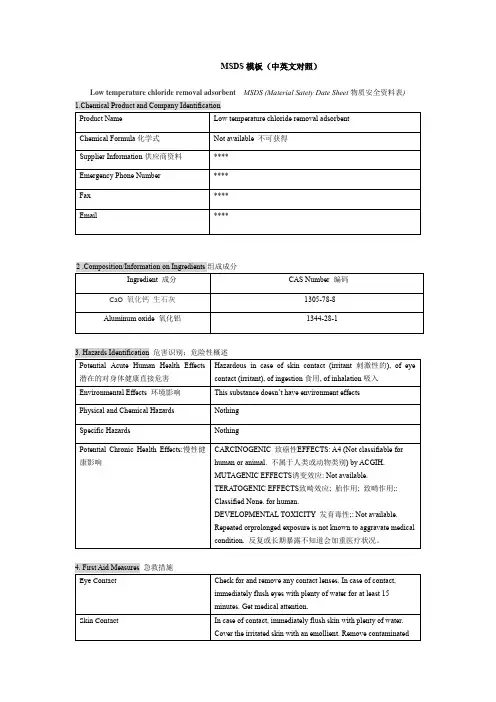
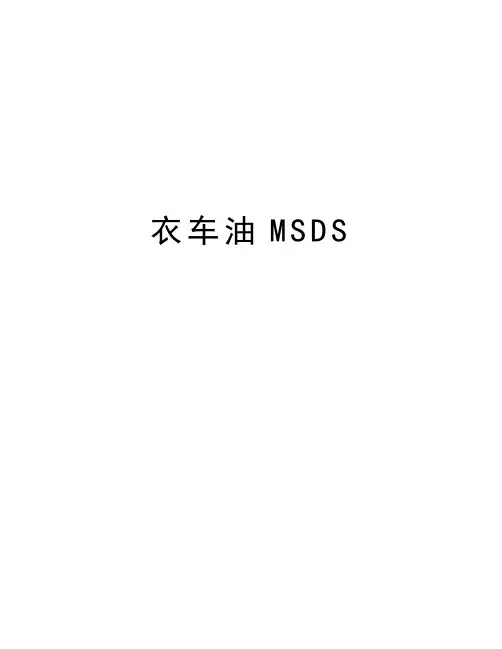
衣车油M S D S化学品安全技术说明书第一部分化学品及企业标识化学品中文名称:衣车油化学品俗名或商品名:化学品英文名称:企业名称:有限公司地址:传真号码:企业应急电话:生效日期:2009年06月01日第二部分成分/组成信息混合物化学品名称:衣车油有害物成分含量 LEAD无无无第三部分危险性概述危险性类别:水溶性不烯烧侵入途径:吞服环境危害:本产品为环保、绿色产品、无毒、无公害。
燃爆危险:本产品为水溶性,不烯烧。
使用中应远离炎源避免阳光直接照和射,没有使用完的产品,桶盖密闭,以免质变。
第四部分急求措施皮肤接触:脱去污染的衣着,用清水彻底冲洗皮肤。
吸入:无特殊反应食入:现时末发现会对健康或生命构成危害。
第五部分消防措施危险特性:没有有害燃烧产物:CO灭火方法及灭火剂:水溶性系统本身不能燃烧,但当所有水分蒸发后,所残留物质可燃烧,要扑灭大火,可用全能型的泡沫火剂,对于小火燃烧,可用二氧化碳及化学干粉灭火剂。
第六部分泄露应急处理。
应急处理:大量物质溢漏应有容器收集后并弃置,小量物质溢漏时,如果当地法规允许,将其冲入下水道。
废物弃置方法:在当地法规允许下,可采用焚化及堆填于泥土中。
(弃置物暴露在空气中会自然蒸发水分变成无害的普通固体塑胶)第七部分操作处置与储存操作注意事项:防止阳光长时间暴晒。
储存注意事项:储存于阴凉、通风库房。
仓温不宜超过60℃。
保持容器密封。
应与氧化剂、食用化学品分开存放,切忌混储。
储存区应备有泄露应急入处理设备和合适的收容的材料。
第八部分接触控制/个体防护最高容许浓度:中国(MAC)对空气无影响监测方法:气相色谱法工程控制:加强通风。
呼吸系统防护:无害物质,无需特别防护。
眼睛防护:无害物质,无需特别防护。
身体防护:无害物质,无需特别防护。
手防护:无害物质,无需特别防护。
其他防护:工作现场禁止吸烟。
第九部分理化特性外观与性状:无味乳白色液休粘度:100-300cps/25℃相对密度(水=1):1.0/25℃固含量:(37±2)%沸点(℃):99溶解性:可溶于水主要用途:辅助UV上光,可使面油对印品有更高的附著力。
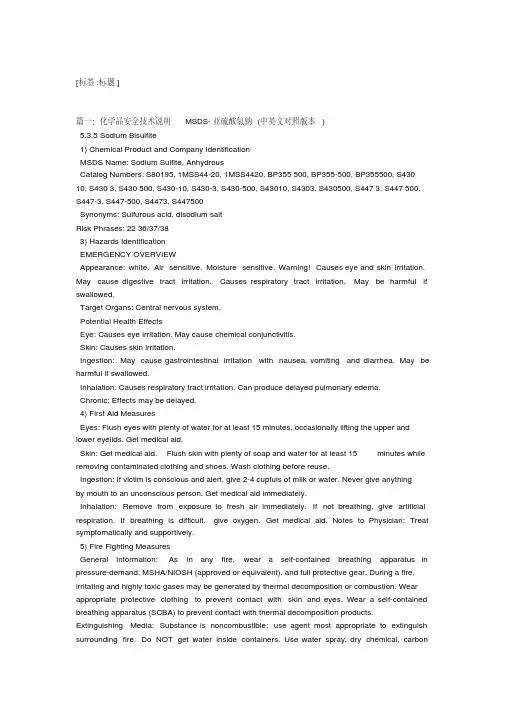
[标签:标题]篇一:化学品安全技术说明MSDS-亚硫酸氢钠(中英文对照版本)5.3.5 Sodium Bisulfite1) Chemical Product and Company IdentificationMSDS Name: Sodium Sulfite, AnhydrousCatalog Numbers: S80195, 1MSS44-20, 1MSS4420, BP355 500, BP355-500, BP355500, S430 10, S430 3, S430 500, S430-10, S430-3, S430-500, S43010, S4303, S430500, S447 3, S447 500,S447-3, S447-500, S4473, S447500Synonyms: Sulfurous acid, disodium saltRisk Phrases: 22 36/37/383) Hazards IdentificationEMERGENCY OVERVIEWAppearance: white. Air sensitive. Moisture sensitive. Warning! Causes eye and skin irritation. May cause digestive tract irritation. Causes respiratory tract irritation. May be harmful if swallowed.Target Organs: Central nervous system.Potential Health EffectsEye: Causes eye irritation. May cause chemical conjunctivitis.Skin: Causes skin irritation.Ingestion: May cause gastrointestinal irritation with nausea, vomiting and diarrhea. May be harmful if swallowed.Inhalation: Causes respiratory tract irritation. Can produce delayed pulmonary edema.Chronic: Effects may be delayed.4) First Aid MeasuresEyes: Flush eyes with plenty of water for at least 15 minutes, occasionally lifting the upper and lower eyelids. Get medical aid.Skin: Get medical aid. Flush skin with plenty of soap and water for at least 15 minutes while removing contaminated clothing and shoes. Wash clothing before reuse.Ingestion: If victim is conscious and alert, give 2-4 cupfuls of milk or water. Never give anythingby mouth to an unconscious person. Get medical aid immediately.Inhalation: Remove from exposure to fresh air immediately. If not breathing, give artificial respiration. If breathing is difficult, give oxygen. Get medical aid. Notes to Physician: Treat symptomatically and supportively.5) Fire Fighting MeasuresGeneral Information: As in any fire, wear a self-contained breathing apparatus in pressure-demand, MSHA/NIOSH (approved or equivalent), and full protective gear. During a fire, irritating and highly toxic gases may be generated by thermal decomposition or combustion. Wear appropriate protective clothing to prevent contact with skin and eyes. Wear a self-contained breathing apparatus (SCBA) to prevent contact with thermal decomposition products. Extinguishing Media: Substance is noncombustible; use agent most appropriate to extinguish surrounding fire. Do NOT get water inside containers. Use water spray, dry chemical, carbon。
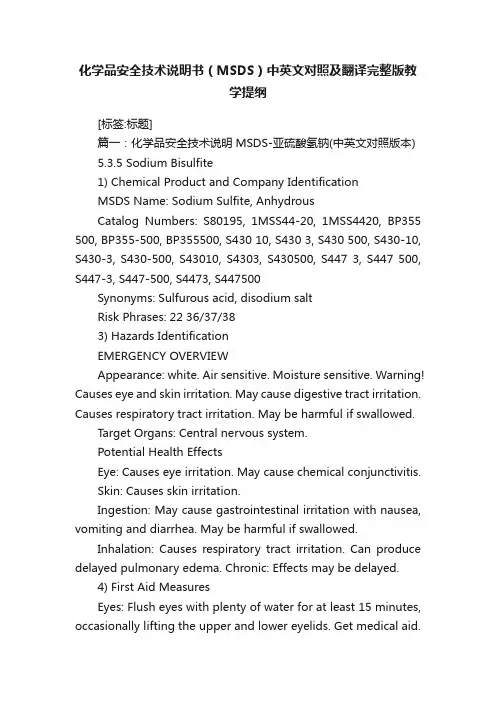
化学品安全技术说明书(MSDS)中英文对照及翻译完整版教学提纲[标签:标题]篇一:化学品安全技术说明MSDS-亚硫酸氢钠(中英文对照版本)5.3.5 Sodium Bisulfite1) Chemical Product and Company IdentificationMSDS Name: Sodium Sulfite, AnhydrousCatalog Numbers: S80195, 1MSS44-20, 1MSS4420, BP355 500, BP355-500, BP355500, S430 10, S430 3, S430 500, S430-10, S430-3, S430-500, S43010, S4303, S430500, S447 3, S447 500, S447-3, S447-500, S4473, S447500Synonyms: Sulfurous acid, disodium saltRisk Phrases: 22 36/37/383) Hazards IdentificationEMERGENCY OVERVIEWAppearance: white. Air sensitive. Moisture sensitive. Warning! Causes eye and skin irritation. May cause digestive tract irritation. Causes respiratory tract irritation. May be harmful if swallowed.Target Organs: Central nervous system.Potential Health EffectsEye: Causes eye irritation. May cause chemical conjunctivitis.Skin: Causes skin irritation.Ingestion: May cause gastrointestinal irritation with nausea, vomiting and diarrhea. May be harmful if swallowed.Inhalation: Causes respiratory tract irritation. Can produce delayed pulmonary edema. Chronic: Effects may be delayed.4) First Aid MeasuresEyes: Flush eyes with plenty of water for at least 15 minutes, occasionally lifting the upper and lower eyelids. Get medical aid.Skin: Get medical aid. Flush skin with plenty of soap and water for at least 15 minutes while removing contaminated clothing and shoes. Wash clothing before reuse.Ingestion: If victim is conscious and alert, give 2-4 cupfuls of milk or water. Never give anything by mouth to an unconscious person. Get medical aid immediately.Inhalation: Remove from exposure to fresh air immediately. If not breathing, give artificial respiration. If breathing is difficult, give oxygen. Get medical aid. Notes to Physician: Treat symptomatically and supportively.5) Fire Fighting MeasuresGeneral Information: As in any fire, wear a self-contained breathing apparatus in pressure-demand, MSHA/NIOSH (approved or equivalent), and full protective gear. During a fire, irritating and highly toxic gases may be generated by thermal decomposition or combustion. Wear appropriate protective clothing to prevent contact with skin and eyes. Wear a self-contained breathing apparatus (SCBA) to prevent contact with thermal decomposition products. Extinguishing Media: Substance is noncombustible; use agent most appropriate to extinguish surrounding fire. Do NOT get water inside containers. Use water spray, dry chemical, carbondioxide, or appropriate foam.6) Accidental Release MeasuresGeneral Information: Use proper personal protective equipment as indicated in Section 8.Spills/Leaks: Vacuum or sweep up material and place into a suitable disposal container. Clean up spills immediately, observing precautions in the Protective Equipment section. Avoid generating dusty conditions. Provide ventilation. Place under aninert atmosphere. Do not get water inside containers.7) Handling and StorageHandling: Wash thoroughly after handling. Use with adequate ventilation. Minimize dust generation and accumulation. Avoid contact with eyes, skin, and clothing. Keep container tightly closed. Avoid ingestion and inhalation. Handle under an inert atmosphere. Store protected from air. Do not allow contact with water. Wash clothing before reuse. Keep from contact with moist air and steam.Storage: Store in a tightly closed container. Keep from contact with oxidizing materials. Store in a cool, dry, well-ventilated area away from incompatible substances. Keep away from strong acids. Do not expose to air. Store protected from moisture. Store under an inert atmosphere.8) Exposure Controls, Personal ProtectionEngineering Controls: Facilities storing or utilizing this material should be equipped with an eyewash facility and a safety shower. Use adequate ventilation to keep airborne concentrations low.listed for this chemical.Personal Protective EquipmentEyes: Wear appropriate protective eyeglasses or chemical safety goggles as described by OSHA's eye and face protection regulations in 29 CFR 1910.133 or European Standard EN166.Skin: Wear appropriate protective gloves to prevent skin exposure.Clothing: Wear appropriate protective clothing to prevent skin exposure.Respirators: A respiratory protection program that meets OSHA's 29 CFR1910.134 and ANSI Z88.2 requirements or European Standard EN 149 must be followed whenever workplace conditions warrant a respirator's use. Follow the OSHA respirator regulations found in 29CFR 1910.134 or European Standard EN 149. Always use a NIOSH or European Standard EN 149 approved respirator when necessary.9) Physical and Chemical PropertiesPhysical State: SolidAppearance: whiteOdor: odorlesspH: Not available.Vapor Pressure: Not available.Vapor Density: Not available.Evaporation Rate: Not available.Viscosity: Not available.Boiling Point: Not available.Freezing/Melting Point: Not available.Autoignition Temperature: Not available.Flash Point: Not available.Decomposition Temperature: > 500 deg CNFPA Rating: (estimated) Health: 2; Flammability: 0; Reactivity: 0Explosion Limits, Lower: Not available.Upper: Not available.Solubility: 23 g/100 mL water (20°C)Specific Gravity/Density: 2.6330g/cm3Molecular Formula: Na2O3SMolecular Weight: 126.0410) Stability and ReactivityChemical Stability: Stable at room temperature in closedcontainers under normal storage and handling conditions.Conditions to Avoid: Incompatible materials, dust generation, moisture, exposure to air, excess heat.Incompatibilities with Other Materials: Strong oxidizing agents, acids, organics, moisture, air, combustible materials.Hazardous Decomposition Products: Oxides of sulfur.Hazardous Polymerization: Has not been reported.11) Toxicological InformationRTECS#:CAS# 7757-83-7: WE2150000LD50/LC50:CAS# 7757-83-7:Oral, mouse: LD50 = 820 mg/kg;Carcinogenicity:CAS# 7757-83-7: Not listed by ACGIH, IARC, NIOSH, NTP, or OSHA.Epidemiology: No information available.Teratogenicity: No information available.Reproductive Effects: No information available.Neurotoxicity: No information available.Mutagenicity: No information available.Other Studies: No data available.12) Ecological InformationEcotoxicity: No data available. No information available.Environmental: No information found.Physical: No information found.Other: No information available.13) Disposal ConsiderationsChemical waste generators must determine whether a discarded chemical is classified as a hazardous waste. US EPAguidelines for the classification determination are listed in 40 CFR Parts 261.3. Additionally, waste generators must consult state and local hazardous waste regulations to ensure complete and accurate classification. RCRA P-Series: None listed.RCRA U-Series: None listed.US FEDERALTSCACAS# 7757-83-7 is listed on the TSCA inventory.Health & Safety Reporting ListNone of the chemicals are on the Health & Safety Reporting List.Chemical Test RulesNone of the chemicals in this product are under a Chemical Test Rule.Section 12bNone of the chemicals are listed under TSCA Section 12b.TSCA Significant New Use RuleNone of the chemicals in this material have a SNUR under TSCA.SARASection 302 (RQ)None of the chemicals in this material have an RQ.Section 302 (TPQ)None of the chemicals in this product have a TPQ.SARA CodesCAS # 7757-83-7: acute.Section 313No chemicals are reportable under Section 313.Clean Air Act:This material does not contain any hazardous air pollutants.This material does not contain any Class 1 Ozone depletors. This material does not contain any Class 2Ozone depletors.Clean Water Act:None of the chemicals in this product are listed as Hazardous Substances under the CWA. None of the chemicals in this product are listed as Priority Pollutants under the CW A. None of the chemicals in this product are listed as Toxic Pollutants under the CW A.OSHA:None of the chemicals in this product are considered highly hazardous by OSHA. STATECAS# 7757-83-7 is not present on state lists from CA, PA, MN, MA, FL, or NJ.California No Significant Risk Level: None of the chemicals in this product are listed. European/International Regulations European Labeling in Accordance with EC DirectivesHazard Symbols:XNRisk Phrases:R 22 Harmful if swallowed.R 36/37/38 Irritating to eyes, respiratory systemand skin.Safety Phrases:S 24/25 Avoid contact with skin and eyes.WGK (Water Danger/Protection)CAS# 7757-83-7: 1CanadaCAS# 7757-83-7 is listed on Canada's DSL List. CAS# 7757-83-7 is listed on Canada's DSL List.This product has a WHMIS classification of D2B.CAS# 7757-83-7 is not listed on Canada's Ingredient Disclosure List.Exposure Limits16) Additional InformationMSDS Creation Date: 7/15/1999Revision #1 Date: 8/02/2000The information above is believed to be accurate and represents the best information currently available to us. However, we make no warranty of merchantability or any other warranty, express or implied, with respect to such information, and we assume no liability resulting from its use. Users should make their own investigations to determine the suitability of the information for their particular purposes. In no event shall Fisher be liable for any claims, losses, or damages of any third party or for lost profits or any special, indirect, incidental, consequential or exemplary damages, howsoever arising, even if Fisher has been advised of the possibility of such damages. 5.3.5亚硫酸氢钠1)化学品名称化学品中文名称:亚硫酸氢钠化学品英文名称:sodium bisulfite篇二:化学品安全技术说明书(MSDS)篇三:详细化学品安全技术说明书(MSDS)化学品安全技术说明书二〇〇六年二月目录表1-001 乙炔气............ 1 表1-002 表1-003 表1-004 表1-005 表1-006 表1-007 表1-008 表1-009 表1-010 表1-011 表1-012 表1-013 氧气.............. 二氧化碳......... 氢气............. 氩气............. 甲烷............. 四氢噻吩......... 活性炭........... 三乙胺........... 硫代磷酰氯....... 硫黄............ 甲胺磷........... 多聚甲醛........ 5 11 13 15 17 19 21 23 25 27 30 32表1-014(附表1-3)甲缩醛34 表1-015 黄磷............ 36 表1-016 氯.............. 38 表1-017 表1-018 表1-019 表1-020 表1-021 表1-022 表1-023 表1-024 表1-025 表1-026 表1-027 表1-028 三氯化磷......... 甲醇............. 液碱............. 氨水............. 硫酸二甲酯....... 甲胺磷........... 液氨............. 氯仿............. 二氯乙烷......... 二硫化碳......... 甲苯............. 盐酸............. 41 45 47 49 52 54 57 59 61 64 66 68表1-029 氯甲烷........... 71 表1-030 硫酸............. 73 表1-031 二甲苯........... 76 表1-032 表1-033 表1-034 表1-035 表1-036 表1-037 表1-038 表1-039 表1-040 表1-041 表1-042 表1-043 醋酸酐........... 多聚甲醛......... 草甘膦........... 稻瘟灵........... 异丙胺........... 漂白粉........... 氯化氢........... 氰化氢........... 氰化钠........... 氯乙酸........... 甲缩醛........... 丙烯腈.......... 78 81 82 84 86 88 90 93 95 97 99 102。
MSDS培训课件课件一、教学内容本节课我们将学习MSDS(物质安全数据表)的相关知识。
教学内容主要涉及教材第十二章《化学品的安全与管理》中的第三节“物质安全数据表的理解与应用”。
具体内容包括:MSDS的基本概念、组成部分、关键信息识别以及其在日常工作和生活中的应用。
二、教学目标1. 了解MSDS的基本概念,掌握其组成部分和关键信息。
2. 学会阅读和理解MSDS,提高化学品安全管理的意识和能力。
3. 培养学生在实际工作中运用MSDS解决问题的能力。
三、教学难点与重点难点:MSDS关键信息的识别和应用。
重点:MSDS的基本概念、组成部分及阅读理解方法。
四、教具与学具准备1. 教具:PPT课件、实物样品、化学品安全手册。
2. 学具:笔记本、教材、签字笔。
五、教学过程1. 实践情景引入(5分钟)通过展示一个实际工作中遇到的问题,如化学品泄漏,引导学生思考如何利用MSDS解决问题。
2. 基本概念讲解(10分钟)介绍MSDS的定义、作用和重要性。
3. MSDS组成部分及关键信息识别(15分钟)详细讲解MSDS的各个组成部分,如化学品名称、成分、危害信息等,并通过实例分析,引导学生识别关键信息。
4. 例题讲解(10分钟)选取具有代表性的MSDS例题,讲解阅读理解和应用方法。
5. 随堂练习(10分钟)让学生阅读MSDS,找出关键信息,并回答相关问题。
6. 应用讨论(15分钟)分组讨论MSDS在实际工作和生活中的应用场景,分享经验和心得。
六、板书设计1. 板书MSDS培训课件2. 板书内容:MSDS基本概念MSDS组成部分关键信息识别应用场景七、作业设计1. 作业题目:1)什么是MSDS?2)MSDS包括哪些组成部分?3)如何识别MSDS中的关键信息?结合实际工作或生活,举例说明MSDS的应用。
2. 答案:问题1:MSDS是物质安全数据表的缩写,是一种提供化学品危害信息的文件。
问题2:MSDS包括化学品名称、成分、危害信息、急救措施、消防措施、操作处置、储存运输等组成部分。
产品-M S D S-物质成分中英文格式
(MATERIAL SAFETY DATA SHEET)
物质安全资料
1. Material and manufacture identification
2. Composition on ingredients
成分辨识资料
3. Hazardous identification
Serious Symptom
Eye: dust and smoke will cause irritation on eyes, and bring about pain and red and swollen. If long time exposed on this atmosphere, will cause eye conjunctivitis。
眼睛:灰尘和烟雾会对眼睛带来刺激,导致疼痛红肿,长时间暴露在该环境下,会导致结膜炎Skin: this material can’t penetrate into the skin, but when contact with the dust directly ,will also cause slight red and swollen.
皮肤:该物料不会直接渗透皮肤,但是直接接触还是会有轻微红肿。
Inhaling: it will cause great damage on human body when inhaling, high concentration dust and smoke will cause hard to breathe, cough, and also make sick and stomachache. Metallic smoke will cause flu-like, and make person hard to breathe, cough, split out, headache, cold, hot, pain,weak,sleepy, and sweaty, this will last 24 hours or may be longer.
吸入:吸入会对人体造成伤害,高浓度的灰尘和烟雾会造成呼吸困难,咳嗽,导致胃痛或是恶
心。
金属烟雾会导致流感,产生呼吸困难,咳嗽,呕吐,头痛,发冷,发热,疼痛,虚弱,嗜
睡,多汗,症状会持续24小时或是更长时间。
Eat: when people eat them will make sick
食用:食用导致人恶心
Potential affection: skin exposed such environment for long time will cause severe irritation or dermatitis. However, Pb also cause human organ damage and human nerve damage.
潜在慢性影响:长时间皮肤暴露会造成严重刺激,或是皮肤炎。
然而,铅会造成器官受损
4.First aids
5.Fire-Protection measurement
6. Leakage emergency treatment
7.Handling and storage
8.Exposed protective measurement
9.Physical and chemical properties 理化特性
10. Stability and reactivity
11. Toxicological information
12.Ecological information
13.Scrap disposal
14. Transportation
w and regulation
16.Others。